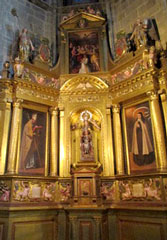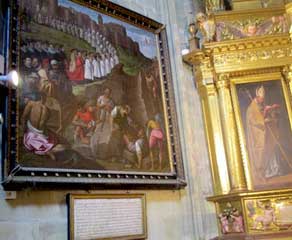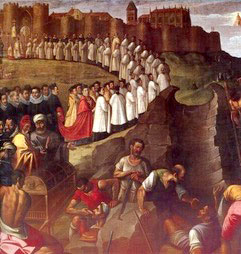From David Bartholomae –

 We just did another piece of the Camino de Santiago and ended up in Astorga, which has one of the pilgrimage route’s lovely small cathedrals. This one had an ex voto.
We just did another piece of the Camino de Santiago and ended up in Astorga, which has one of the pilgrimage route’s lovely small cathedrals. This one had an ex voto.
The panel below the painting tells the story of the collapse of scaffolding as the cathedral was being built. With the intervention of St. James (Santiago), the men were saved.
From Mariolina Salvatori –
I so admire you for your persistence on this wonderful pilgrimage.
Thanks for thinking of me. I am glad ex votos and prayer cards bring me to mind. I wonder how those who do not know about ex votos read this painting. And I need to think about how the presence and monumental size of this ex voto, and the fact that it is displayed next to the main altar, and that it was obviously commissioned to a reputable painter, impact the tradition of the ex voto. In this case it is not the humble person, but the Cathedral itself that was in peril …
From David Bartholomae –
So, you prompted me to do my homework. We couldn’t get close enough to the text to be able to read it when we were in the cathedral. (see Bernardo Velado Graña, “Juan De Peñalosa y Sandoval: Un pintor cordobes en la cathedral de astorga”)
 The painter is Juan de Peñalosa, a painter of some significance who did other paintings in the cathedral (and across Spain) and who also worked on the new baroque retable. He also painted the other images in this chapel. The painting dates from somewhere between 1616 and 1623. The event dates from 1436. The story is that two workmen fell into a well and were saved by an intervention from “the majestic virgin” (la virgin de majestad). (If you were to address the King, you would address him as “majestad.”)
The painter is Juan de Peñalosa, a painter of some significance who did other paintings in the cathedral (and across Spain) and who also worked on the new baroque retable. He also painted the other images in this chapel. The painting dates from somewhere between 1616 and 1623. The event dates from 1436. The story is that two workmen fell into a well and were saved by an intervention from “the majestic virgin” (la virgin de majestad). (If you were to address the King, you would address him as “majestad.”)
And you are right about the odd point of focus in the painting. The miracle is represented in the lower right corner and the virgin is a tiny figure in the upper right corner. The focus is on the long parade of bishops, monks, priests and noblemen to celebrate the saving of the men (el Cabildo Catedral) — it is their clerical power that is celebrated, particularly Bishop Messia de Tovar, who wears the “capa magna.” The painter is also in the painting (I’m not sure which figure) — he is, the article says, looking out at us. There are also some shepherds with their dogs, a reminder of our salvation.
The painting is highly valued now because it shows the old city walls and the work that was being done on the old Romanesque cathedral in the 17th century. They were refashioning the building in gothic style — the façade is now a highly elaborated rococo, which does not appeal to my sensibilities! The tower, for instance, is gone and replaced by two towers.
– Exchange between David Bartholomae and Mariolina Salvatori
